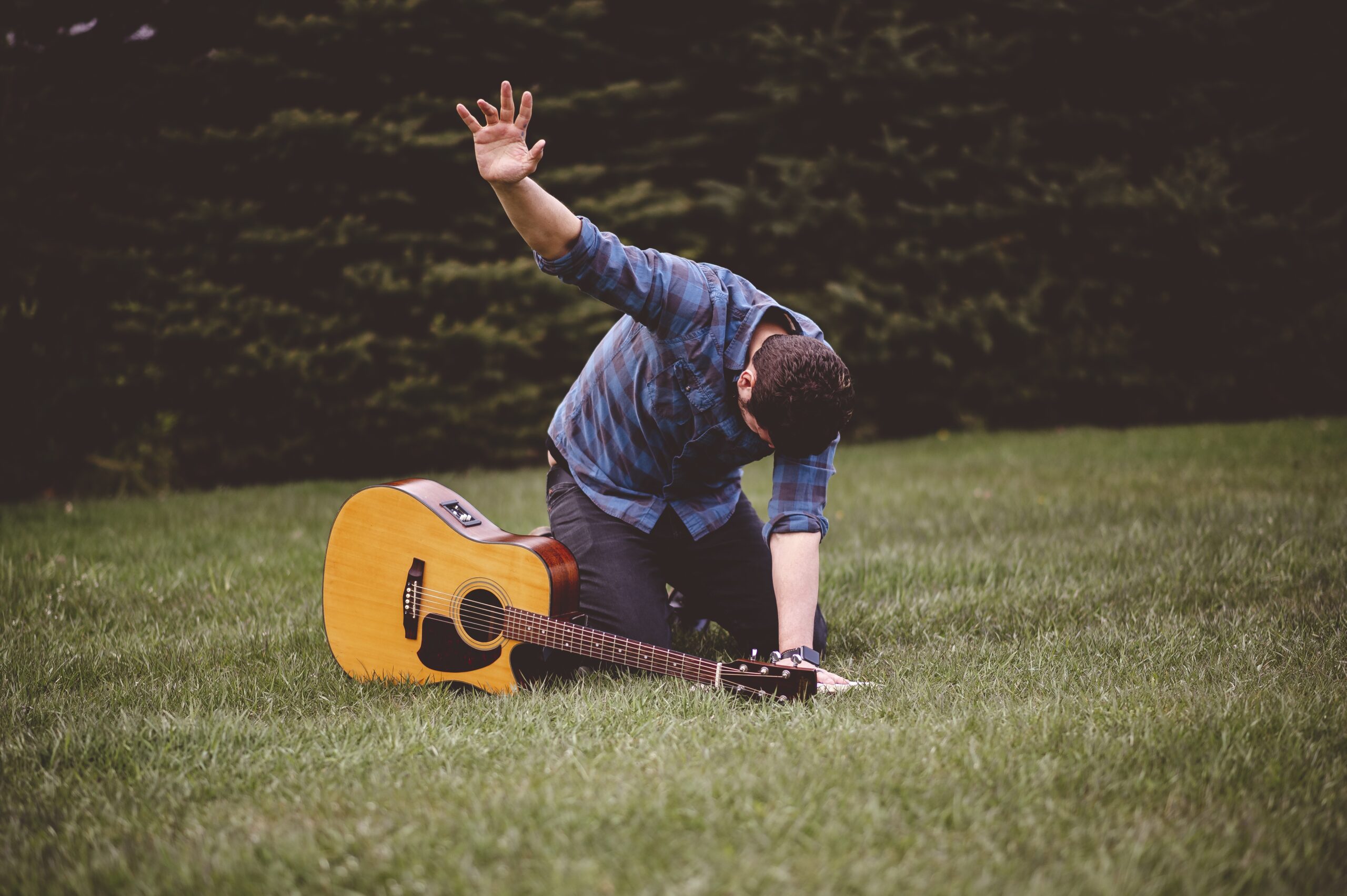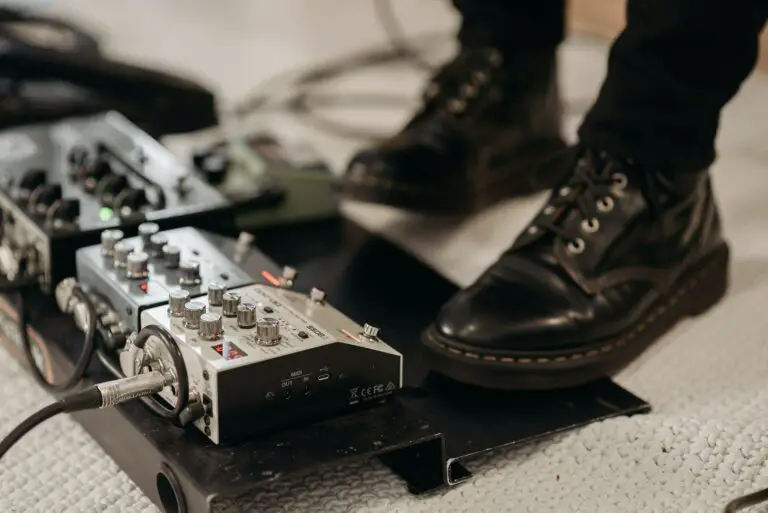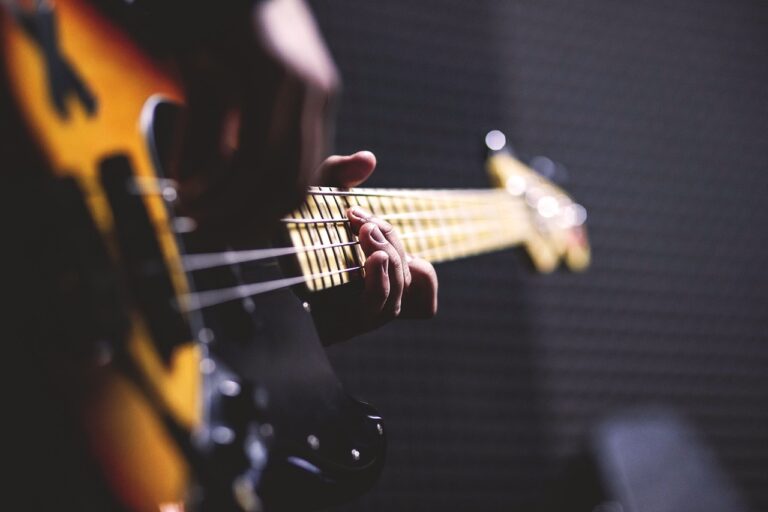Can You Play An Acoustic Guitar In The Rain?
Playing an acoustic guitar in the rain: it’s a question that many guitarists might find themselves pondering, especially when faced with unpredictable weather or outdoor events.
While the concept may have a certain romantic appeal, the reality involves a host of potential issues, mainly because acoustic guitars are crafted from wood, a material known to be sensitive to water and moisture.
Playing an acoustic guitar in the rain is generally not advised, as the moisture can cause serious damage to the wood and other components of the guitar. However, it can be done using for shorts amount of time or with protective covering.
It is recommended to dry the guitar immediately after use to prevent lasting damage.
In this article, we will dive into the reality of playing an acoustic guitar in the rain.
We’ll go over the potential damages rain can cause to the instrument, and what protective measures can be enacted to help protect your acoustic guitar from water damage.
How Does Rain Affect Wood?
Rain, essentially water, has a profound impact on wood, a hygroscopic material that can absorb and release moisture from its surroundings.
When wood comes into contact with water, it swells, as the cells absorb the moisture, leading to potential warping, bending, or cracking.
Moreover, constant changes in moisture levels can cause wood to continuously expand and contract, reducing its structural integrity over time.
Prolonged exposure to water in some cases can also lead to bigger issues like mold and wood rot.
These conditions can degrade the quality of the guitar over time.
The Specific Impacts of Rain on the Types of Wood Typically Used in Acoustic Guitars
In the world of acoustic guitars, the most common woods utilized include spruce, cedar, mahogany, and rosewood, each bringing its own unique sound characteristics to an instrument.
- Spruce: Often used for guitar tops, spruce is known for its stiff yet lightweight properties. Rain can cause spruce wood to swell and potentially warp, altering the sound quality and playability of the guitar.
- Cedar: Commonly used in classical guitars, cedar is softer compared to spruce and can be more susceptible to moisture damage. It can absorb water quickly, leading to a distorted shape and compromised sound quality.
- Mahogany: Utilized for guitar bodies and necks, mahogany is relatively dense and can withstand some level of moisture better than softer woods. However, exposure to rain can still cause it to swell, affecting the guitar’s setup and action.
- Rosewood: A popular choice for fretboards, rosewood is naturally oily, offering some resistance to moisture. Nevertheless, prolonged exposure to rain can strip away its natural oils, making it susceptible to cracking and warping.
It is clear that while these woods have been chosen for their acoustic properties, they also come with a vulnerability to water damage.
When a guitar crafted from these materials encounters rain, it is not just the shape and structure that are at risk, but the very sound and soul of the instrument.
Therefore, playing an acoustic guitar in the rain, without proper protection, poses a risk to the longevity and performance of the instrument.
Rain and Acoustic Guitars: Short-Term and Long-Term Damage
Understanding the repercussions of exposing an acoustic guitar to rain involves breaking down the potential damages into immediate, short-term effects and more gradual, long-term effects.
Let’s delve deeper into what can occur in both scenarios.
Immediate Damage That Can Occur
Once an acoustic guitar is exposed to rain, it is prone to several potential immediate issues. The guitar’s wood can start swelling, leading to problems such as:
- Warping: The wood can become distorted, affecting the guitar’s structure and playability.
- Finish Damage: The guitar’s finish might become cloudy or exhibit “blushing,” where white marks appear on the surface.
- Electrical Components: If the guitar is equipped with electronic components, they might suffer damage, leading to malfunctions.
These damages not only affect the appearance but also the sound quality and performance of the guitar.
Potential Long-Term Damage to an Acoustic Guitar from Moisture Exposure
Even if a guitar seems fine after being in the rain, moisture might have penetrated deeper layers of the wood. This sets the stage for long-term issues such as:
- Wood Rot: Over time, accumulated moisture can lead to wood rot, which compromises the guitar’s structural integrity.
- Fret Damage: The frets may oxidize and corrode, which affects playability and necessitates costly repairs.
- Glue Deterioration: The glue holding different parts of the guitar can weaken, leading to parts becoming loose or detaching over time.
- Mold and Mildew: Moist environments can foster the growth of mold and mildew, which not only smells unpleasant but can also health hazards and deteriorate the wood further.
- Altered Sound: The most heartbreaking of all is the gradual loss of the original sound quality, with the guitar losing its rich tones and harmonies, transforming into an instrument that sounds dull and lifeless.
While it is generally advised against playing your acoustic guitar in the rain due to potential damages, there are circumstances where you might find it necessary to play outdoors where rain is a possibility.
In such cases, taking preventative measures can help in safeguarding your guitar to a certain extent. Let’s explore some tips and techniques that can be useful.

Tips to Keep Your Guitar Dry
- Use a Waterproof Cover: Consider using a waterproof cover or case that can quickly shield your guitar if it starts raining.
- Positioning: Try to position yourself in a way where your body shields the guitar from the rain to the best extent possible.
- Quick Wipe Down: Keep a dry cloth handy to quickly wipe down your guitar in case it gets wet to prevent water from seeping into the wood.
- Avoid Puddles: Be mindful of where you are standing and avoid places where water can splash onto your guitar, like near puddles.
Techniques for Playing in Wet Conditions
- Quick Set-Up and Break-Down: Learn to set up and break down your setup quickly to minimize exposure to rain.
- Reduced Playing Time: Limit your playing time to reduce the exposure of your guitar to wet conditions.
- Humidity Control: Consider using humidity control products in your guitar case to help maintain an optimal level of humidity for your guitar.
Creative Approaches to Playing Guitar in the Rain
- Umbrella Holder: Invest in a microphone stand with an umbrella holder to keep you and your guitar dry while playing.
- Alternative Materials: Explore guitars made with alternative materials that are more resistant to water damage for rainy day performances.
- Play with the Theme: Embrace the rainy setting by choosing songs that go well with the sound and mood of the rain, creating a unique and harmonious performance.
By applying these strategies, you can mitigate the risks associated with playing your acoustic guitar in the rain.
Other Protective Measures
Playing in the rain doesn’t necessarily have to signal a death sentence for your guitar.
Implementing protective measures can play a crucial role in safeguarding your instrument against the perils of moisture and rain.
Next, we will look at various protective accessories and maintenance tips that can shield your guitar from water damage.
Waterproof Cases and Covers for Acoustic Guitars
Whether you’re braving a drizzle or caught in an unexpected downpour, having a waterproof case can save your guitar. These can be in the form of:
- Hardshell Cases with Waterproof Seal: These cases offer robust protection against physical damages and are often equipped with a waterproof seal to prevent water ingress.
- Waterproof Gig Bags: Lighter than hard cases, these bags are designed with waterproof materials to keep your guitar dry.
- Rain Covers: These are specialized covers that you can quickly throw over your guitar to protect it from sudden rains.
Make sure to choose a case or cover that fits your guitar properly to ensure maximum protection.
Quick-Dry Techniques for Guitars
In the unfortunate event that your guitar does get wet, quick-dry techniques can potentially prevent severe damage. Some steps to consider are:
- Immediate Wipe Down: Use a dry cloth to wipe down all surfaces of the guitar immediately.
- Use Silica Gel: Place silica gel packets in the guitar case to absorb moisture quickly.
- Room Drying: Allow your guitar to dry in a room with controlled humidity to prevent warping from rapid drying.
- Seek Professional Help: If the guitar is soaked, it is best to seek professional help for drying and potential repairs.
Maintenance Tips to Prevent Damage
Regular maintenance can build your guitar’s resistance to moisture. Consider the following:
- Hydrate the Wood: Regularly hydrate the wood of your guitar with appropriate products to maintain its health and moisture-resistance.
- Seal Cracks and Openings: Ensure that any cracks or openings are sealed to prevent moisture from seeping in.
- Regular Inspections: Routinely inspect your guitar for signs of water damage and address any issues promptly to prevent long-term damages.
Being prepared and having a well-maintained guitar can be your best defense against the unpredictable weather.
While protective measures can mitigate damage, they cannot eliminate the risk entirely. This highlights the need to exercise caution when playing your acoustic guitar in the rain.
Final Thoughts
Playing an acoustic guitar in the rain is a risk that can lead to serious damage to the instrument. The damage can impact both its structure and sound quality.
While there are protective measures available,, they can only minimize the risks, not eliminate them completely.
If playing in wet conditions is unavoidable, taking precautionary steps and preparations an potentially save your guitar from irreversible damage








